- Position: partial shade
- Soil: fertile, well-drained soil
- Rate of growth: slow-growing
- Hardiness: fully hardyA pair of these tightly clipped box spheres look great flanking a set of steps, a doorway or a path. One of our recommended plants, they're perfect for planting in a large terracotta pot in a partially shady site, where the glossy, dark-green leaves provide all year foliage, interest and structure. Box are happy growing in a sunnier spot, but the combination of dry soil and full sun may encourage poor growth and leaf scorching. If you have sandy soil it is best to keep them in a partially shady spot in the garden.
- Garden care: Ensure that the soil or compost is never allowed to dry out. Trim plants grown as hedges or topiary in mid- or late summer. If you want to maintain a really precise outline, then you can clip it twice a year - once in June, and then again in August/September. Apply a top-dressing of a balanced slow-release fertiliser such as blood, fish and bone (organic) or Growmore (inorganic) around the base of the plant in spring, making sure that none touches the leaves or stems.
-
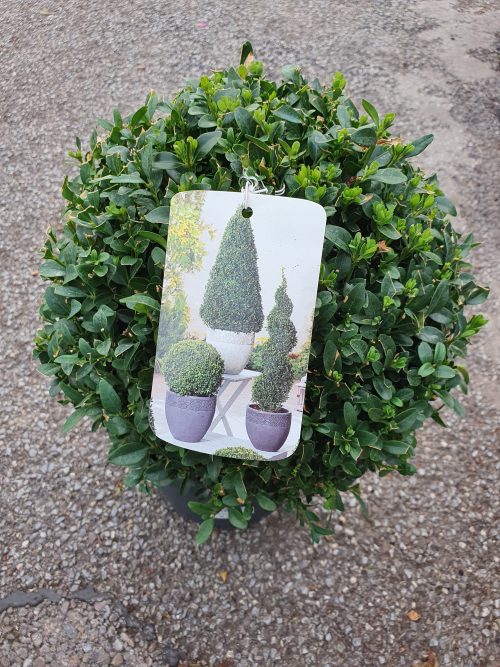
-
Out of stock
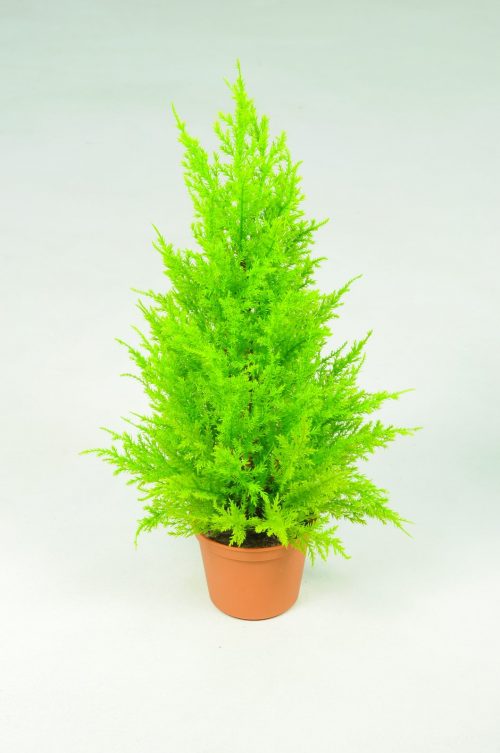 Cupressus macrocarpa 'Goldrest Wilma' is one of the most attractive golden-foliage columnar conifers. Bright golden-yellow foliage. Any free-draining soil in sun or partial shade. Rate of growth up to 60cm per year. Can be used for hedging but doesn't trim quite as well as leylandii. If used for hedging, plant 60-90cm apart. Can be trimmed to keep at the required height Plant Size • Mature Height: 10m • Mature Spread: 2-3m Why We Love It • These trees work wonderfully as topiaries • Fresh lemony scent • Easy to maintain What To Know • Fruit Season: Fall • Position: Full sun • Soil: Well drained • Rate of Growth: Moderate to fast How to Care • In general, growing lemon cypress is not difficult. The trees require well-draining soil, but are not picky about whether it is loamy, sandy or chalky. They also accept acidic, neutral or alkaline soil. • Water regularly - weekly, or more often in extreme heat or containers. • Trimming/Pruning If this plant is used for hedging, it will need to be pruned regularly. It will have to be trimmed to maintain the required height. Use sharp pruning shears to remove the sucker branches and the errant branches that are growing in the wrong direction or making it difficult to fertilize the tree. Since lemon cypress has a conical habit, trim the tree as per its natural shape. Trimming should be done every week during the summer. • Fertilizer Fertilize with the standard, slow-releasing fertilizer that has an equal amount of nitrogen, phosphorus, and potassium once a month. You can also supplement the soil annually with turf fertilizers that contain other nutrients such as magnesium, boron, copper, and zinc
Cupressus macrocarpa 'Goldrest Wilma' is one of the most attractive golden-foliage columnar conifers. Bright golden-yellow foliage. Any free-draining soil in sun or partial shade. Rate of growth up to 60cm per year. Can be used for hedging but doesn't trim quite as well as leylandii. If used for hedging, plant 60-90cm apart. Can be trimmed to keep at the required height Plant Size • Mature Height: 10m • Mature Spread: 2-3m Why We Love It • These trees work wonderfully as topiaries • Fresh lemony scent • Easy to maintain What To Know • Fruit Season: Fall • Position: Full sun • Soil: Well drained • Rate of Growth: Moderate to fast How to Care • In general, growing lemon cypress is not difficult. The trees require well-draining soil, but are not picky about whether it is loamy, sandy or chalky. They also accept acidic, neutral or alkaline soil. • Water regularly - weekly, or more often in extreme heat or containers. • Trimming/Pruning If this plant is used for hedging, it will need to be pruned regularly. It will have to be trimmed to maintain the required height. Use sharp pruning shears to remove the sucker branches and the errant branches that are growing in the wrong direction or making it difficult to fertilize the tree. Since lemon cypress has a conical habit, trim the tree as per its natural shape. Trimming should be done every week during the summer. • Fertilizer Fertilize with the standard, slow-releasing fertilizer that has an equal amount of nitrogen, phosphorus, and potassium once a month. You can also supplement the soil annually with turf fertilizers that contain other nutrients such as magnesium, boron, copper, and zinc -
Out of stock
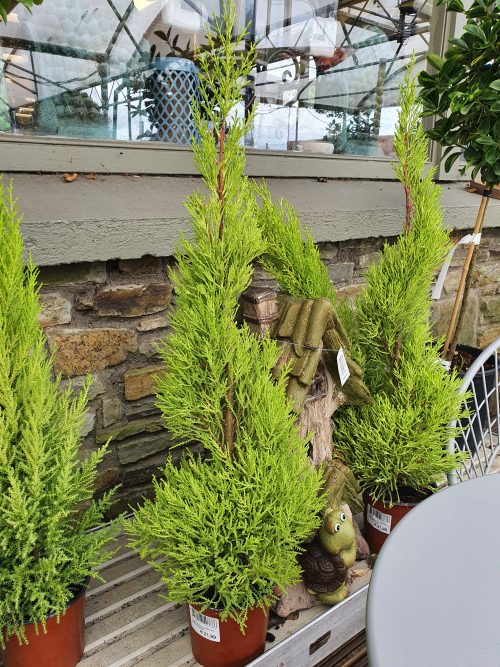
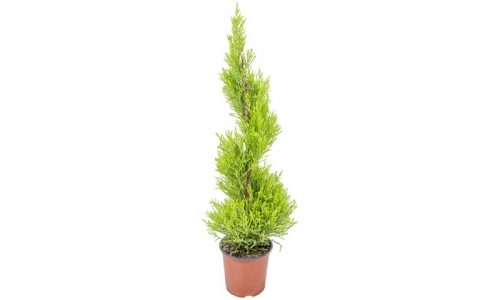 Cupressus macrocarpa 'Goldrest Wilma' is one of the most attractive golden-foliage columnar conifers. Bright golden-yellow foliage. Any free-draining soil in sun or partial shade. Rate of growth up to 60cm per year. Can be used for hedging but doesn't trim quite as well as leylandii. If used for hedging, plant 60-90cm apart. Can be trimmed to keep at the required height Plant Size • Mature Height: 10m • Mature Spread: 2-3m Why We Love It • These trees work wonderfully as topiaries • Fresh lemony scent • Easy to maintain What To Know • Fruit Season: Fall • Position: Full sun • Soil: Well drained • Rate of Growth: Moderate to fast How to Care • In general, growing lemon cypress is not difficult. The trees require well-draining soil, but are not picky about whether it is loamy, sandy or chalky. They also accept acidic, neutral or alkaline soil. • Water regularly - weekly, or more often in extreme heat or containers. • Trimming/Pruning If this plant is used for hedging, it will need to be pruned regularly. It will have to be trimmed to maintain the required height. Use sharp pruning shears to remove the sucker branches and the errant branches that are growing in the wrong direction or making it difficult to fertilize the tree. Since lemon cypress has a conical habit, trim the tree as per its natural shape. Trimming should be done every week during the summer. • Fertilizer Fertilize with the standard, slow-releasing fertilizer that has an equal amount of nitrogen, phosphorus, and potassium once a month. You can also supplement the soil annually with turf fertilizers that contain other nutrients such as magnesium, boron, copper, and zinc
Cupressus macrocarpa 'Goldrest Wilma' is one of the most attractive golden-foliage columnar conifers. Bright golden-yellow foliage. Any free-draining soil in sun or partial shade. Rate of growth up to 60cm per year. Can be used for hedging but doesn't trim quite as well as leylandii. If used for hedging, plant 60-90cm apart. Can be trimmed to keep at the required height Plant Size • Mature Height: 10m • Mature Spread: 2-3m Why We Love It • These trees work wonderfully as topiaries • Fresh lemony scent • Easy to maintain What To Know • Fruit Season: Fall • Position: Full sun • Soil: Well drained • Rate of Growth: Moderate to fast How to Care • In general, growing lemon cypress is not difficult. The trees require well-draining soil, but are not picky about whether it is loamy, sandy or chalky. They also accept acidic, neutral or alkaline soil. • Water regularly - weekly, or more often in extreme heat or containers. • Trimming/Pruning If this plant is used for hedging, it will need to be pruned regularly. It will have to be trimmed to maintain the required height. Use sharp pruning shears to remove the sucker branches and the errant branches that are growing in the wrong direction or making it difficult to fertilize the tree. Since lemon cypress has a conical habit, trim the tree as per its natural shape. Trimming should be done every week during the summer. • Fertilizer Fertilize with the standard, slow-releasing fertilizer that has an equal amount of nitrogen, phosphorus, and potassium once a month. You can also supplement the soil annually with turf fertilizers that contain other nutrients such as magnesium, boron, copper, and zinc -
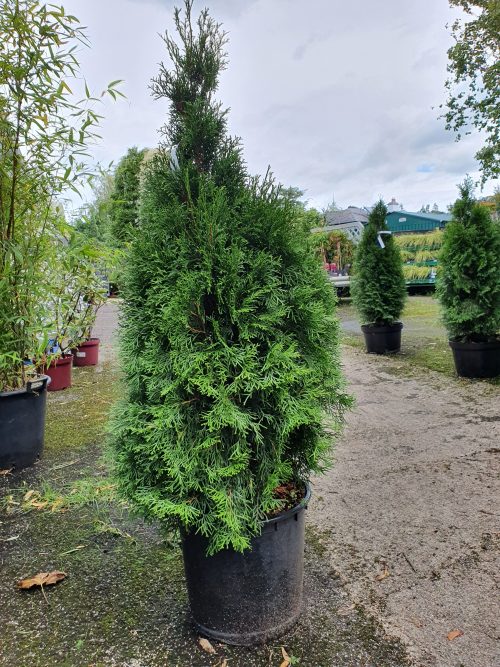 A slow growing, evergreen, erect conifer, Thuja occidentalis Smaragd has scale-like, fresh green leaves that are held closely to the shoots and give a fresh apple-like aroma when crushed. With its narrow, conical shape, Smaragd makes a useful tree for any garden, and is particularly suitable for formal plantings either as an individual specimen or in rows. It is slow to reach its eventual height of around 8-10ft but the narrow, conical shape will broaden out with maturity to reach a diameter of around 6ft. Pot size: 20L Actual height: 100-125cm Site: Very tolerant of inland exposure Soil: Well drained, tolerates clay soils, shallow over chalky soils Position: Full sun, tolerates partial shade Season of Interest: All year round and aromatic foliage Hardiness: Fully hardy Height: 5-8ft (1.5-2.5m) Spread: 3-6ft (1-2m)
A slow growing, evergreen, erect conifer, Thuja occidentalis Smaragd has scale-like, fresh green leaves that are held closely to the shoots and give a fresh apple-like aroma when crushed. With its narrow, conical shape, Smaragd makes a useful tree for any garden, and is particularly suitable for formal plantings either as an individual specimen or in rows. It is slow to reach its eventual height of around 8-10ft but the narrow, conical shape will broaden out with maturity to reach a diameter of around 6ft. Pot size: 20L Actual height: 100-125cm Site: Very tolerant of inland exposure Soil: Well drained, tolerates clay soils, shallow over chalky soils Position: Full sun, tolerates partial shade Season of Interest: All year round and aromatic foliage Hardiness: Fully hardy Height: 5-8ft (1.5-2.5m) Spread: 3-6ft (1-2m) -
Out of stock
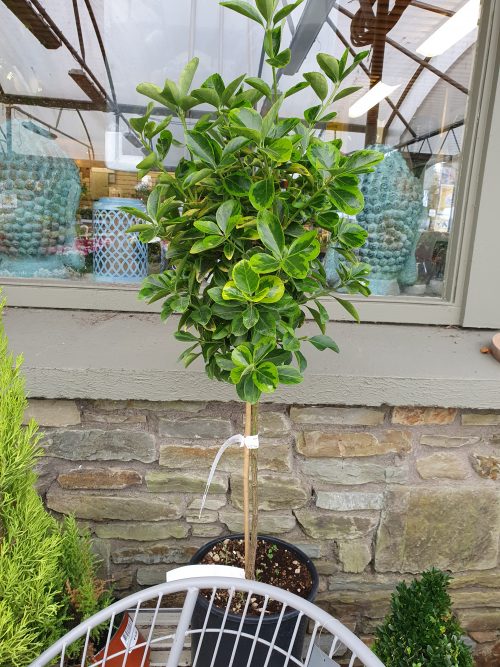
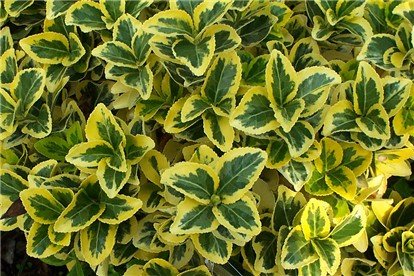 Euonymus japonicus Aureus is an evergreen variety and provides year round interest. Excellent for growing as a specimen shrub or small hedge. Also suitable for coastal areas. The attractive leathery leaves are dark green with bright yellow edges.A Decorative Foliage
Euonymus japonicus Aureus is an evergreen variety and provides year round interest. Excellent for growing as a specimen shrub or small hedge. Also suitable for coastal areas. The attractive leathery leaves are dark green with bright yellow edges.A Decorative Foliage- Pot size: 7.5L
- Height: 4m
- Spread: 2m
- Leaf colour: variegated
- Plant location: sunny
- Plant depth: 15 cm
- Hardiness: -15 Celsius
- Harmful if eaten
- Preferred soil: Grows in any soil
-
Out of stock
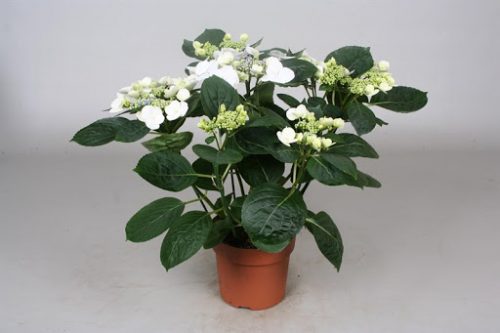
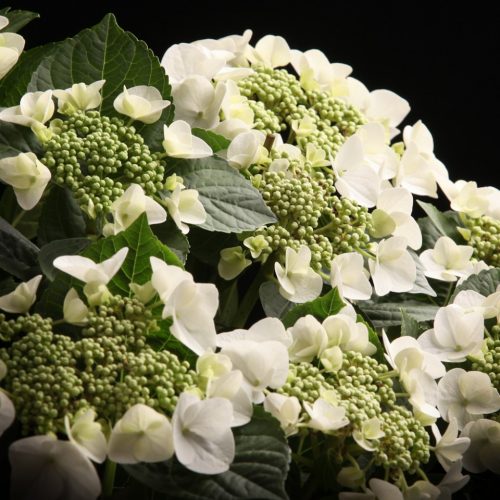 Hydrangea macrophylla ‘Benxi’ Shrubbery suitable for the rock garden rich, fresh, as preferable exposure Partial shade – Shade color White Flowering period is June – September Height 100 cm – 120 cm Density 1 potted seedlings per square meter, Diameter pot 19cm
Hydrangea macrophylla ‘Benxi’ Shrubbery suitable for the rock garden rich, fresh, as preferable exposure Partial shade – Shade color White Flowering period is June – September Height 100 cm – 120 cm Density 1 potted seedlings per square meter, Diameter pot 19cm -
Out of stock
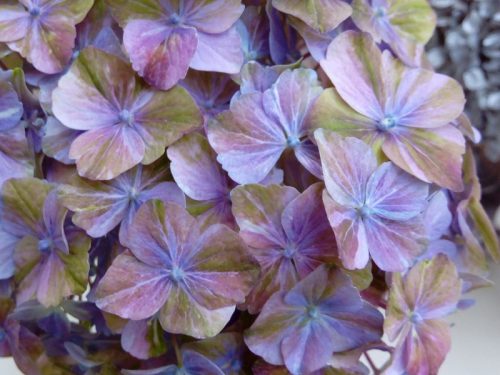 Large purple-green mophead shaped flowerheads with frilly edges when grown in neutral to alkaline soils. Position: They perform best when given a shady, cool moist root run and a sheltered aspect. Maintenance: Mophead hydrangeas require little pruning, simply thin out old stems and remove the dead flowers to a pair of plump green buds in late spring.
Large purple-green mophead shaped flowerheads with frilly edges when grown in neutral to alkaline soils. Position: They perform best when given a shady, cool moist root run and a sheltered aspect. Maintenance: Mophead hydrangeas require little pruning, simply thin out old stems and remove the dead flowers to a pair of plump green buds in late spring.- Flower Colour: Green, Purple
- Flower Type: Mophead
- Flowering Month: June, July, August, September
- Soil Type: Alkaline, Normal
- Aspect: Partial Shade
-
Out of stock
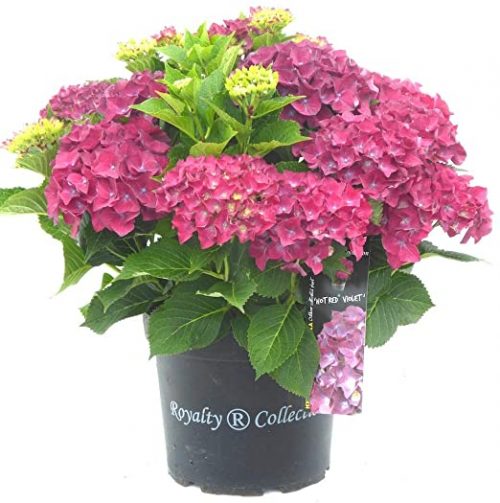 A medium sized deciduous shrub with deep purple/pink-red mophead blooms in summer above dark purple tinged green foliage, when grown in neutral to alkaline soils. Flowers in summer and may change to blue/mauve shades when grown on acidic soils or pink on neutral soils.
A medium sized deciduous shrub with deep purple/pink-red mophead blooms in summer above dark purple tinged green foliage, when grown in neutral to alkaline soils. Flowers in summer and may change to blue/mauve shades when grown on acidic soils or pink on neutral soils.- Flower Colour: Pink, Red
- Flower Type: Mophead
- Flowering Month: June, July, August, September
- Soil Type: Alkaline, Normal
- Aspect: Partial Shade
- Hardiness*: Hardy
- Foliage Type: Deciduous
- Foliage Colour: Green, Bronze/purple
- Height after 10 years*: 0.9-1.2m (3-4ft)
- Pot Size: 3 Litre
-
Out of stock
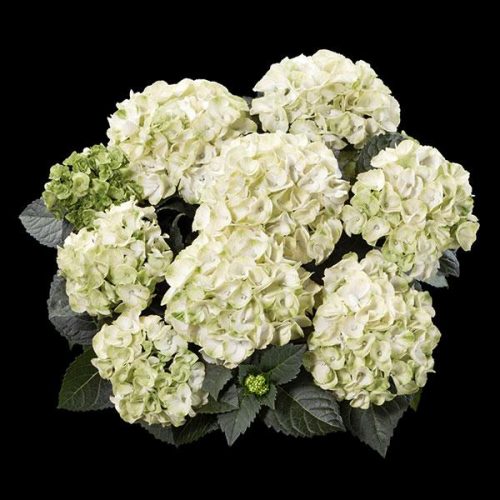 Hydrangea Macrophylla Caipirinha is a compact deciduous shrub with dark green ovate toothed leaves. During the summer it has beautiful rounded clusters of white mop head flowers fading with age to dark green with a red border around each petal at the end of the flower. Eventual height and spread up to 1.2 metres pot size: 3L
Hydrangea Macrophylla Caipirinha is a compact deciduous shrub with dark green ovate toothed leaves. During the summer it has beautiful rounded clusters of white mop head flowers fading with age to dark green with a red border around each petal at the end of the flower. Eventual height and spread up to 1.2 metres pot size: 3L -
Out of stock
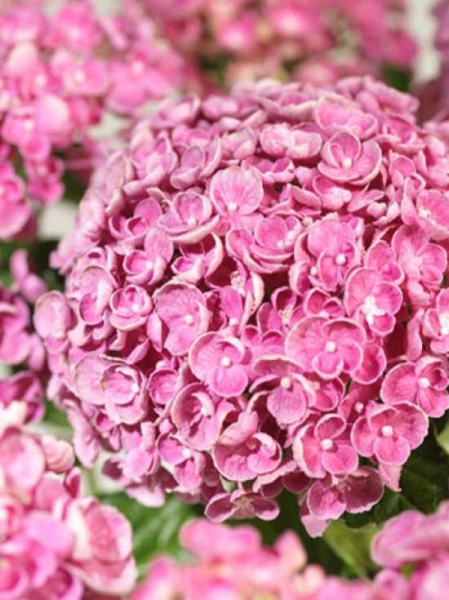
- Flowering Period:June, July, August, September
- Final height:80cm to 100cm
- Final width:80cm to 100cm
- Available:February, March, April, May, June, July, August, September, October, November
- Fragrances:lightly scented
- Use:beds/borders, for containers, as a hedge, for group plantings, as a specimen plant
- Hardiness:hardy
- Soil:moist, heavy, moderately heavy, neutral, acidic, slightly acidic
- Location:partial shade
- Flower Colour:pink, grey
- Leaf Colour:green
-
Out of stock
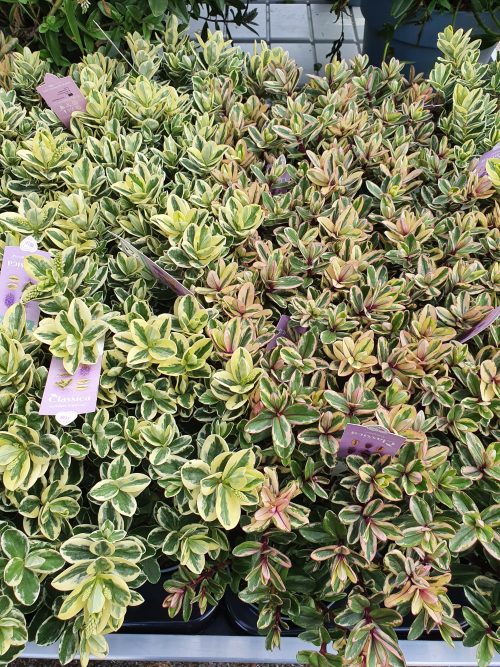 Katrina' is a compact, upright, bushy, evergreen shrub bearing broadly elliptic, grey-green leaves with pale yellow margins and dense racemes of purple flowers in summer. Plant Size • Mature Height: 0.5-1m • Mature Spread: 0.5-1m Why We Love It • Excellent addition to beds, borders and containers • Attracts butterflies and bees What To Know • Season of Interest: Winter-Autumn • Position: Full sun, partial shade • Soil: Moist, well-drained How to Care • The hebe plant does not require a lot of care once it is established. Although the shrub doesn’t need much in the way of fertilizer, you can apply some once a year in late winter or early spring prior to new growth. • Deadheading the spent blooms can be done to help promote additional flowering. You can also trim hebe plants back about halfway after flowering to promote bushier growth. • These shrubs are usually propagated through both seeds and semi-hardwood cuttings taken in summer. • In areas with harsher winters, they should be protected by surrounding them with straw mulch.
Katrina' is a compact, upright, bushy, evergreen shrub bearing broadly elliptic, grey-green leaves with pale yellow margins and dense racemes of purple flowers in summer. Plant Size • Mature Height: 0.5-1m • Mature Spread: 0.5-1m Why We Love It • Excellent addition to beds, borders and containers • Attracts butterflies and bees What To Know • Season of Interest: Winter-Autumn • Position: Full sun, partial shade • Soil: Moist, well-drained How to Care • The hebe plant does not require a lot of care once it is established. Although the shrub doesn’t need much in the way of fertilizer, you can apply some once a year in late winter or early spring prior to new growth. • Deadheading the spent blooms can be done to help promote additional flowering. You can also trim hebe plants back about halfway after flowering to promote bushier growth. • These shrubs are usually propagated through both seeds and semi-hardwood cuttings taken in summer. • In areas with harsher winters, they should be protected by surrounding them with straw mulch. -
Out of stock
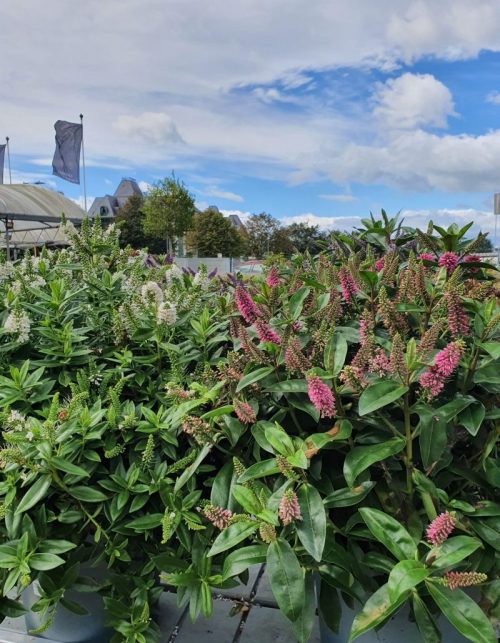 Hebe (Evergreen Veronica) is an easy to grow flowering evergreen shrub native to New Zealand and South America. Hebe plants come in many sizes ranging from dwarf shrubs, suitable for planting in patio pots and rockeries, to large hebe plants that are perfect for planting in a large garden. Many varieties of Hebe flower throughout summer and autumn - some varieties of Hebe flower during the winter. Although mostly hardy, a cold English winter can kill some types of Hebe plants. Hebes especially need to be protected from strong winds. The variegated-leafed Hebes seem to be amongst those most affected by cold winds and wintery weather. Hebes are easy to propagate from cuttings.
Hebe (Evergreen Veronica) is an easy to grow flowering evergreen shrub native to New Zealand and South America. Hebe plants come in many sizes ranging from dwarf shrubs, suitable for planting in patio pots and rockeries, to large hebe plants that are perfect for planting in a large garden. Many varieties of Hebe flower throughout summer and autumn - some varieties of Hebe flower during the winter. Although mostly hardy, a cold English winter can kill some types of Hebe plants. Hebes especially need to be protected from strong winds. The variegated-leafed Hebes seem to be amongst those most affected by cold winds and wintery weather. Hebes are easy to propagate from cuttings.FLOWERS ON A HEBE PLANT
The flowers on a Hebe shrub are small and grouped together in spikes. The colours of Hebe flowers range from white through pink, blue, lilac and purple to bright crimsons.
FOLIAGE
The leaves provide attractive year round foliage with different colours including silver and green, grey, violet, burgundy, bronze and red.BUTTERFLIES
This delightful shrub has flowers which will attract butterflies and bees to your garden.WHERE TO PLANT A HEBE SHRUB
A Hebe is a good all year round foliage plant. Its flowers can provide colour throughout all growing seasons. Grown in mixed plantings of summer annuals the flowers of a Hebe add to the floral display whilst the shape and form of the bush give a sense of stability. Hebe can be grown as an informal hedge - but if clipped back too hard it will not produce so many flowers. The smaller hebes make good ground cover plants or add interest to a rockery. A Hebe should be planted in a well drained soil and, if possible, in a position protected from wind.HOW TO PLANT A HEBE
- Before planting a Hebe soak the roots in water
- Dig a hole twice as wide as the container that the Hebe is in.
- Add a spadeful of compost and some general purpose fertiliser to the soil taken from the hole that you have dug.
- Remove the plant from the pot - tap the sides and base of the container to release the Hebe.
- Place the hebe plant into the hole.
- Fill in the space around the plant with the soil and compost mixture and gently firm with your fingers or tread in.
- Water in with plenty of water.
- Mulch around the base of the plant to help to conserve moisture.
-
Out of stock
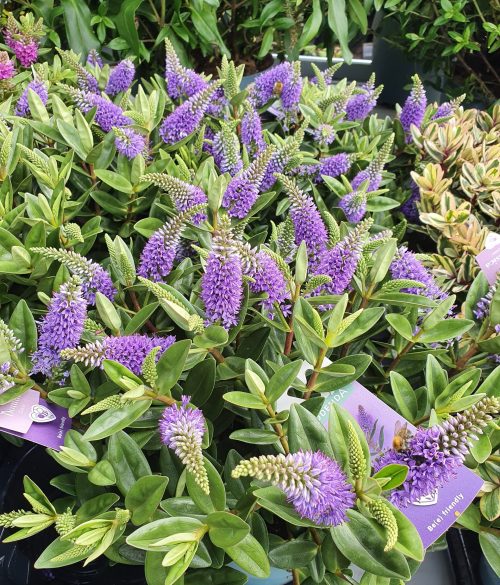 Hebe Donna is a compact evergreen shrub. Mauve blooms appear in July until the first frosts. Deadhead regularly so that more blooms will be produced. Cover with fleece during winter months to protect from frosts. Plant Type: Evergreen Shrub Plant Height & Spread: 100cm x 100cm Foliage Colour: Green Foliage Type: Evergreen Seasons of Interest: All Seasons Soil Condition: Moist, well-drained Planting Position: Full Sun/Light Shade, Sheltered Plant Care & Advice The hebe plant does not require a lot of care once it is established. Although the shrub doesn't need much in the way of fertilizer, you can apply some once a year in late winter or early spring prior to new growth. Growing a hebe plant is very easy. The versatility of these shrubs allows you to grow them in different ways. Use them for edging, plant them in borders, grow them in rock gardens or even in containers. To help keep your Hebe flowering well, remove the dead heads from the plant when they start to shrivel up. You could give your Hebe a trim all over in the early winter. This will help keep your plant attractive and strong.
Hebe Donna is a compact evergreen shrub. Mauve blooms appear in July until the first frosts. Deadhead regularly so that more blooms will be produced. Cover with fleece during winter months to protect from frosts. Plant Type: Evergreen Shrub Plant Height & Spread: 100cm x 100cm Foliage Colour: Green Foliage Type: Evergreen Seasons of Interest: All Seasons Soil Condition: Moist, well-drained Planting Position: Full Sun/Light Shade, Sheltered Plant Care & Advice The hebe plant does not require a lot of care once it is established. Although the shrub doesn't need much in the way of fertilizer, you can apply some once a year in late winter or early spring prior to new growth. Growing a hebe plant is very easy. The versatility of these shrubs allows you to grow them in different ways. Use them for edging, plant them in borders, grow them in rock gardens or even in containers. To help keep your Hebe flowering well, remove the dead heads from the plant when they start to shrivel up. You could give your Hebe a trim all over in the early winter. This will help keep your plant attractive and strong. -
Out of stock
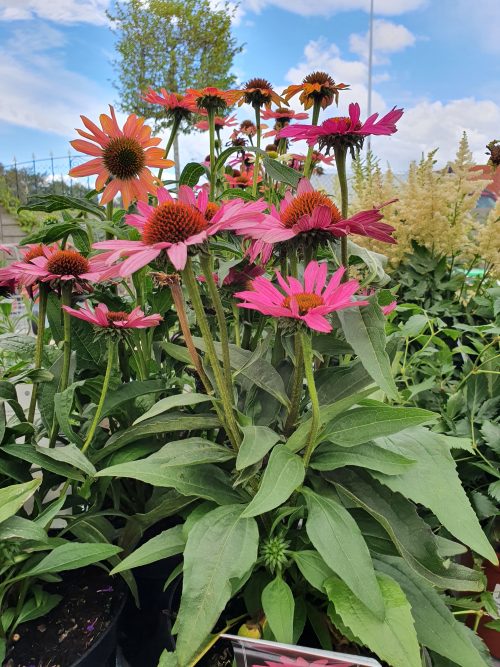
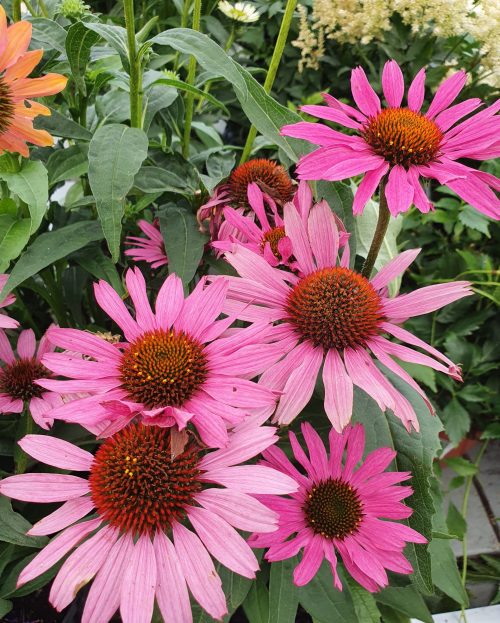 Echinaceas have grown in popularity in recent years, thanks to the trend for prairie-style planting. They’re easy to grow as they tolerate most soils, and their sturdy nature means that staking is unnecessary. Echinacea purpurea has pink, daisy-like flowers with a large, cone-shaped centre. It’s perfect for growing in drifts among the border or among grasses and rudbeckias in a prairie-style planting scheme, and is extremely attractive to pollinators. Its flowers are long-lived and are excellent for cutting.
Echinaceas have grown in popularity in recent years, thanks to the trend for prairie-style planting. They’re easy to grow as they tolerate most soils, and their sturdy nature means that staking is unnecessary. Echinacea purpurea has pink, daisy-like flowers with a large, cone-shaped centre. It’s perfect for growing in drifts among the border or among grasses and rudbeckias in a prairie-style planting scheme, and is extremely attractive to pollinators. Its flowers are long-lived and are excellent for cutting.Characteristics
- Plant Type: Herbaceous perennial
- Habit: Tall, upright flower
- Fully Grown Size: 90-120cm
- Flower Colour: Purple / pink petals with orange / brown centre
- Flower heads can reach 12cm in size
- Flowering Time: Summer to early Autumn
- Sow: In early to mid Spring
- Spacing: 60-80cm
- Hardiness: Hardy
- With big flower heads, Echinacea have grown in popularity in recent years
- These tall & brightly coloured, daisy-like flowers are essential in any garden
- Suited to both traditional, cottage & modern planting schemes
- Plant at back of borders with other herbaceous plants
- Best when planted in clumps / blocks
- Can also be planted in long sweeping drifts
- Companion plants include Rudbeckia, Agapanthus, Verbena, Red Hot Pokers etc..
- Ideal for cut flower gardens
Planting Instructions
- Soak pots in water before sowing
- Choose a location
- Grow in full sun
- Deep, fertile soil that is well drained
- Chose a sheltered spot
- Spacing: 60-80cm apart
- Prepare bed by digging over soil & adding fertilizer or manure
- Dig hole roughly twice the size of the plant pot
- Handle pots with care
- Squeeze side of pots to remove plant
- Firm in well
- Soak soil well after planting
- Feed every 2 to 3 weeks
- Can lift & divide clumps every 3 years
-
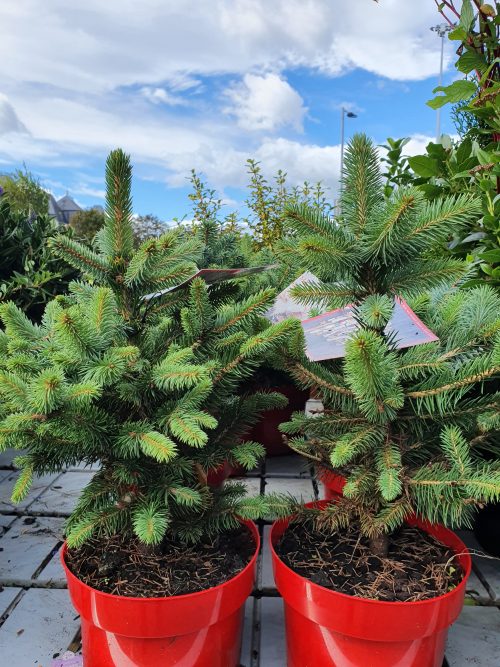
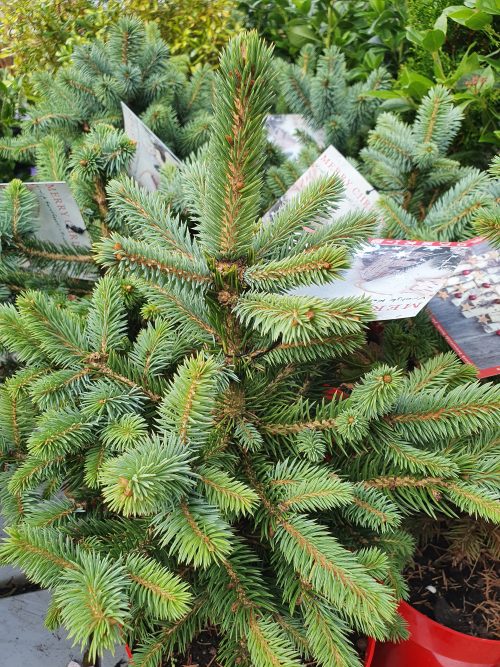 A nice and compact slow growing conifer, which keeps its tight conical shape for many years. Picea glauca is an easy to grow conifer requiring little maintenance, suitable for pots or as a specimen in a shrub bed. With age it will form a 3m tall sturdy looking domed tree. Site: Inland exposed Soil: Well drained, will tolerate acid to alkaline Position: Full sun Season of Interest: Evergreen, nice shape Hardiness: Fully hardy Height: Slowly up to 10ft (3m) in 20-30 years
A nice and compact slow growing conifer, which keeps its tight conical shape for many years. Picea glauca is an easy to grow conifer requiring little maintenance, suitable for pots or as a specimen in a shrub bed. With age it will form a 3m tall sturdy looking domed tree. Site: Inland exposed Soil: Well drained, will tolerate acid to alkaline Position: Full sun Season of Interest: Evergreen, nice shape Hardiness: Fully hardy Height: Slowly up to 10ft (3m) in 20-30 years -
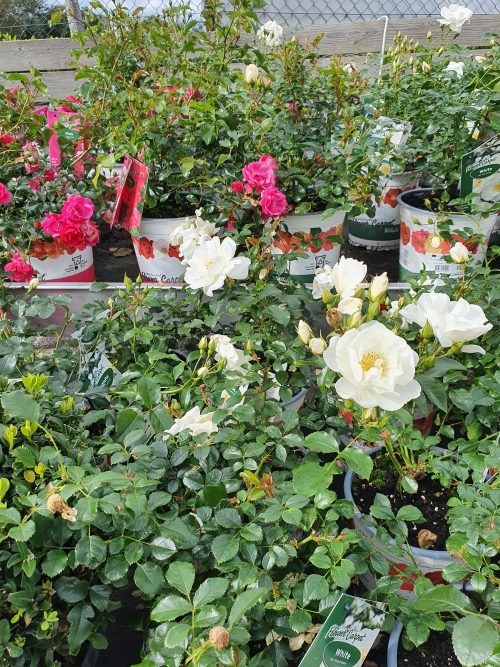 Lower Carpet Roses – also often referred to as The Carpet Rose – are the world’s number one ground cover rose. Once established, some varieties can produce an astonishing display of up to 2,000 flowers from spring through to autumn. They’re extraordinarily low maintenance and have exceptional disease resistance. Better still, once established their well-developed root system means they’re drought and low-water tolerant: surface roots take up available surface water while deeper roots access lower level water in drought conditions. As for pruning, once a year in late winter or early spring, all you need is a pair of garden shears to cut them back by a third any which way. This is the rose that needs no guessing, no worrying. Really… No kidding. Simple to grow and easy to maintain, it doesn't require spraying. Simply cut back to a third of its size once in late Winter or early Spring. And during the long flowering season, this rose will self-clean so that there's no need for fancy pruning or deadheading. Key Features •Masses of iridescent blooms •Rich glossy green foliage •Attractive bush shape and appearance •Disease-resistance, easy-care maintenance •Easy care •No fancy pruning required
Lower Carpet Roses – also often referred to as The Carpet Rose – are the world’s number one ground cover rose. Once established, some varieties can produce an astonishing display of up to 2,000 flowers from spring through to autumn. They’re extraordinarily low maintenance and have exceptional disease resistance. Better still, once established their well-developed root system means they’re drought and low-water tolerant: surface roots take up available surface water while deeper roots access lower level water in drought conditions. As for pruning, once a year in late winter or early spring, all you need is a pair of garden shears to cut them back by a third any which way. This is the rose that needs no guessing, no worrying. Really… No kidding. Simple to grow and easy to maintain, it doesn't require spraying. Simply cut back to a third of its size once in late Winter or early Spring. And during the long flowering season, this rose will self-clean so that there's no need for fancy pruning or deadheading. Key Features •Masses of iridescent blooms •Rich glossy green foliage •Attractive bush shape and appearance •Disease-resistance, easy-care maintenance •Easy care •No fancy pruning required -
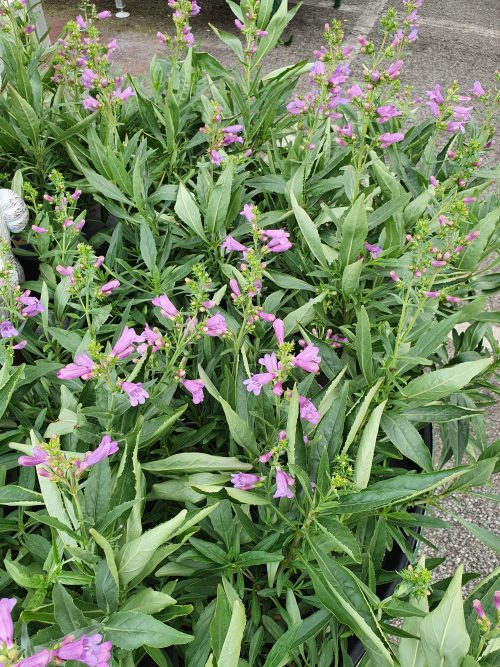 Penstemon are a genus of plants that are annual or perennial,most being semi-evergreen or evergreen.Fully to half hardy,these true conoisseur's plants carry sprays of tubular foxglove like flowers throughout the summer. Penstemons signal warm summer days and are excellent for cottage gardens,borders and summer tubs. Pot size: 1.5L Flowering time: all summer long Position: likes full sun and well drained fertile soil
Penstemon are a genus of plants that are annual or perennial,most being semi-evergreen or evergreen.Fully to half hardy,these true conoisseur's plants carry sprays of tubular foxglove like flowers throughout the summer. Penstemons signal warm summer days and are excellent for cottage gardens,borders and summer tubs. Pot size: 1.5L Flowering time: all summer long Position: likes full sun and well drained fertile soil -
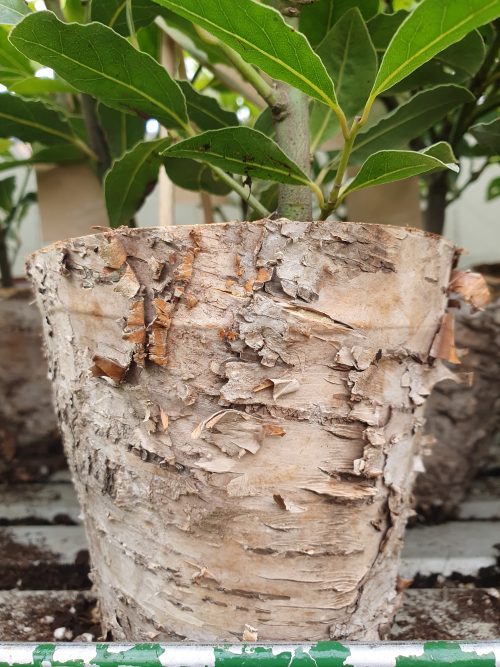
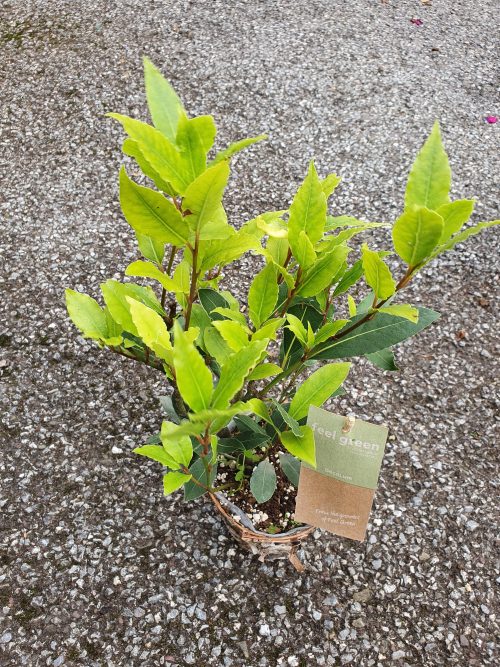 This sustainable laurel adds a Mediterranean touch to your garden (summer)/ house (winter).
This sustainable laurel adds a Mediterranean touch to your garden (summer)/ house (winter). -
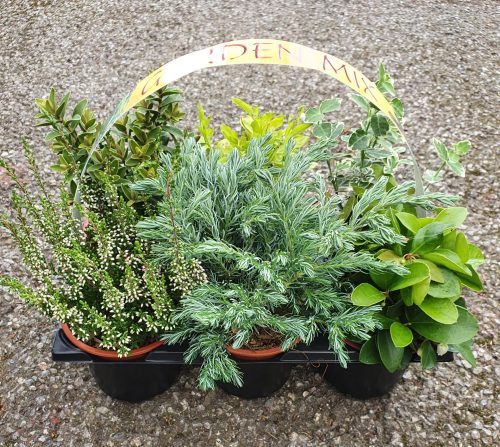
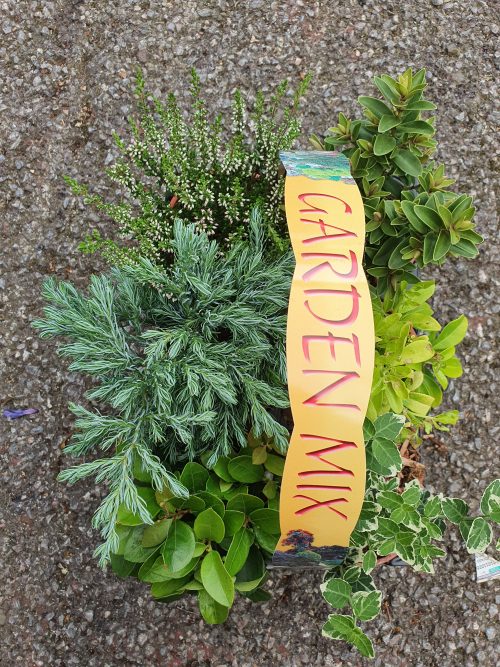 Conifers and Shrubs in 6 pack mixed.
Conifers and Shrubs in 6 pack mixed. -
Out of stock
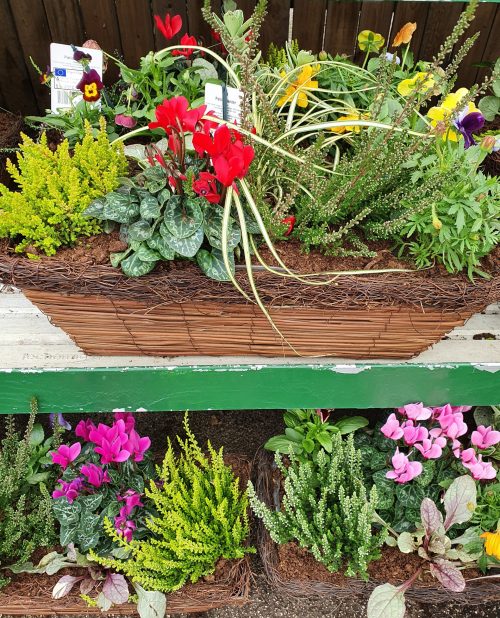
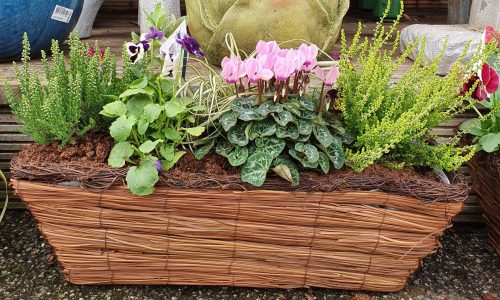 Patio Planter 53cm Window Box Wicker Position: Position planter outside in full natural light.When planted with summer bedding protect from frost. Plant care: Remove dead flower heads regularly to encourage new growth and blooms. Water/Feeding: Water the planter regularly and more frequently in hot or windy conditions.Feed on a regular basis with liquid fertilizer.
Patio Planter 53cm Window Box Wicker Position: Position planter outside in full natural light.When planted with summer bedding protect from frost. Plant care: Remove dead flower heads regularly to encourage new growth and blooms. Water/Feeding: Water the planter regularly and more frequently in hot or windy conditions.Feed on a regular basis with liquid fertilizer. -
Out of stock
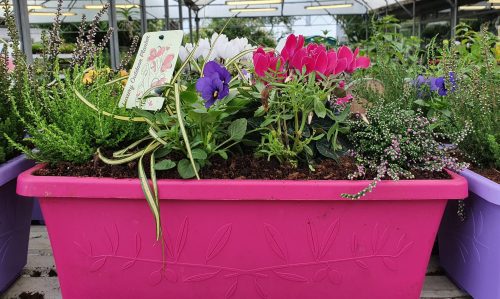 40cm Window Box Position: Avoid full sun or deep shade. Plant care: Remove dead flower heads regularly to encourage new growth and blooms. Water/Feeding: Water the planter regularly and more frequently in hot or windy conditions.Feed on a regular basis with liquid fertilizer.
40cm Window Box Position: Avoid full sun or deep shade. Plant care: Remove dead flower heads regularly to encourage new growth and blooms. Water/Feeding: Water the planter regularly and more frequently in hot or windy conditions.Feed on a regular basis with liquid fertilizer. -
Out of stock
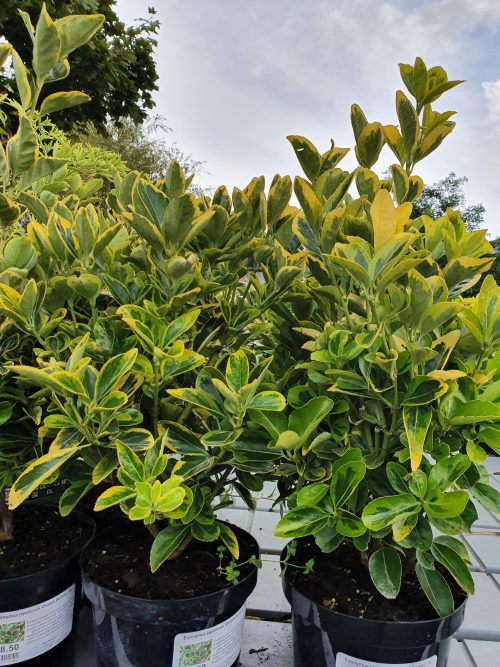 Euonymus Japonicus Aureus is an evergreen variety and provides year round interest. Excellent for growing as a specimen shrub or small hedge. Also suitable for coastal areas. The attractive leathery leaves are dark green with bright yellow edges.Decorative foliage
Euonymus Japonicus Aureus is an evergreen variety and provides year round interest. Excellent for growing as a specimen shrub or small hedge. Also suitable for coastal areas. The attractive leathery leaves are dark green with bright yellow edges.Decorative foliage -
Out of stock
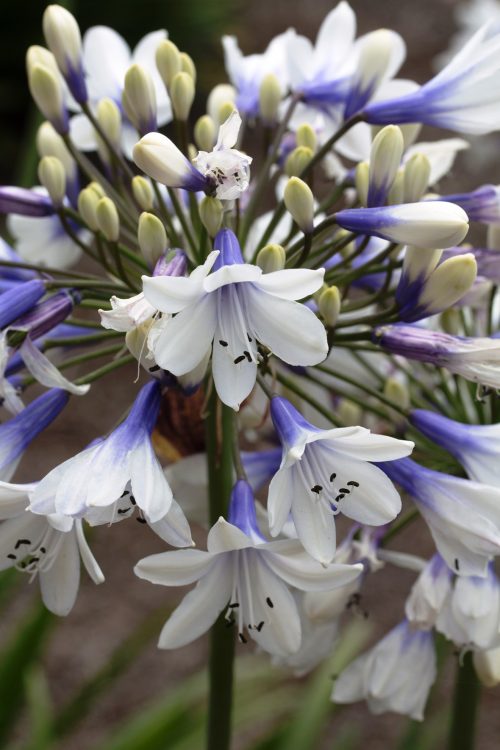
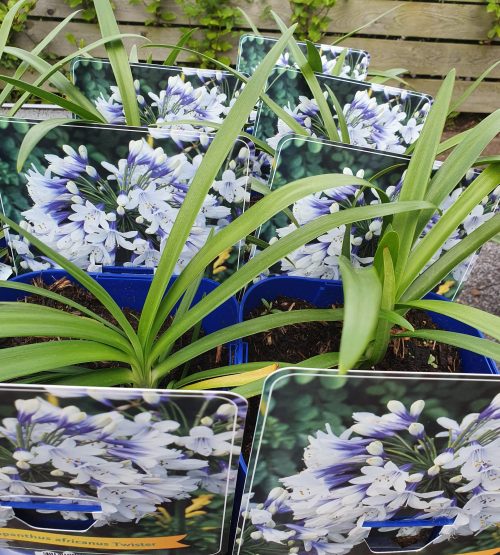 A compact, bi-coloured form of Agapanthus or African lily, Agapanthus Twister is a clump-forming, deciduous perennial, ideal for the smaller garden. Strap-like, deep green leaves appear in spring. From July to September, large, globular flower-heads of trumpet-shaped, white florets with a violet-blue base are borne on sturdy stems. African lilies are very good in pots, grown in soil-based compost with slow-release fertiliser granules, as they flower well when their roots are confined, but be aware that pot-grown plants are more vulnerable to frost, so the pots should be brought under cover in winter in colder areas. African lily Twister holds the RHS Award of Garden Merit. Site: Sheltered Soil: Any light, moisture-retentive, well-drained soil Position: Full sun Season of interest: July to September Hardiness: Fairly hardy Height: 70cm Spread: 40cm
A compact, bi-coloured form of Agapanthus or African lily, Agapanthus Twister is a clump-forming, deciduous perennial, ideal for the smaller garden. Strap-like, deep green leaves appear in spring. From July to September, large, globular flower-heads of trumpet-shaped, white florets with a violet-blue base are borne on sturdy stems. African lilies are very good in pots, grown in soil-based compost with slow-release fertiliser granules, as they flower well when their roots are confined, but be aware that pot-grown plants are more vulnerable to frost, so the pots should be brought under cover in winter in colder areas. African lily Twister holds the RHS Award of Garden Merit. Site: Sheltered Soil: Any light, moisture-retentive, well-drained soil Position: Full sun Season of interest: July to September Hardiness: Fairly hardy Height: 70cm Spread: 40cm -
Out of stock
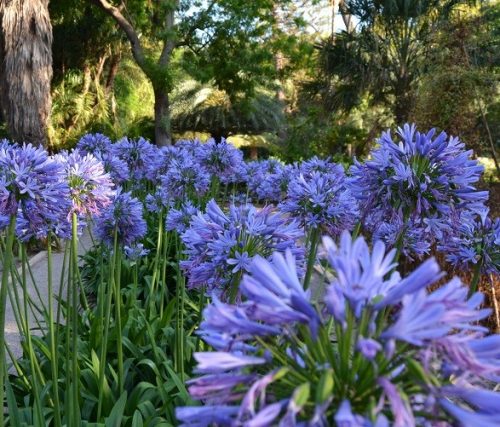
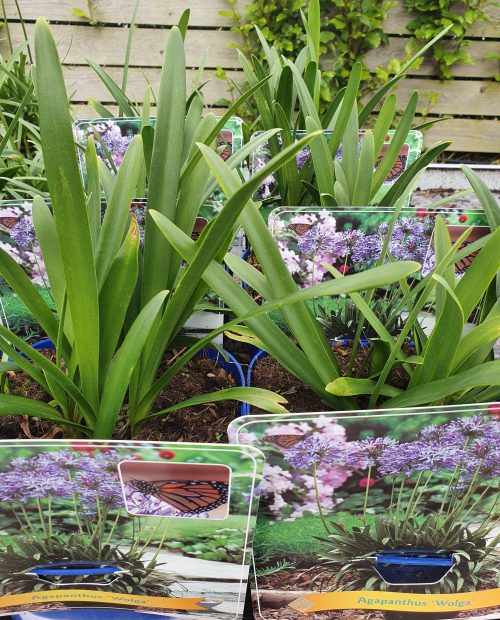 Agapanthus Wolga, Deciduous green strap-like leaves. Pale violet-blue flowers, flowerhead 18-20cm in diameter. Grows up to 70cm tall. Requires full sun and moist well drained soil conditions. Give winter protection. Site: Sheltered Soil: Any light, moisture-retentive, well-drained soil Position: Full sun Season of interest: July to September Hardiness: Fairly hardy Height: 70cm Spread: 40cm
Agapanthus Wolga, Deciduous green strap-like leaves. Pale violet-blue flowers, flowerhead 18-20cm in diameter. Grows up to 70cm tall. Requires full sun and moist well drained soil conditions. Give winter protection. Site: Sheltered Soil: Any light, moisture-retentive, well-drained soil Position: Full sun Season of interest: July to September Hardiness: Fairly hardy Height: 70cm Spread: 40cm